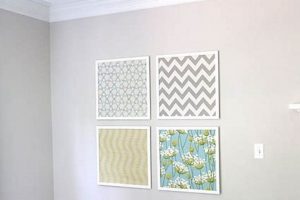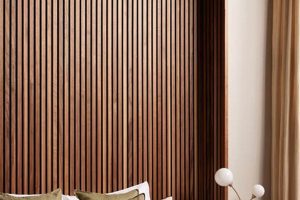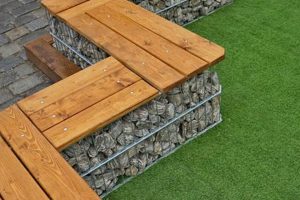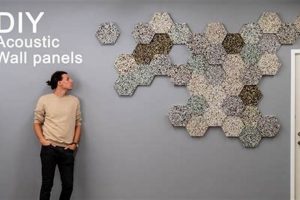A movable outdoor screen designed for seclusion and constructed by individuals, often featuring casters for ease of relocation, exemplifies adaptable landscaping. Such structures provide a customizable solution for creating intimate spaces on decks or terraces. They generally involve assembling a frame and attaching a cladding material, with the addition of wheels to enhance mobility.
The significance of these adaptable screens lies in their capacity to offer immediate privacy, wind protection, and aesthetic enhancement to outdoor living areas. Their portability allows for reconfiguration of spaces based on need or preference. Historically, freestanding screens have served a similar purpose, but the incorporation of wheels introduces a modern element of flexibility and convenience.
The subsequent sections will delve into design considerations, material selection, construction techniques, and safety measures for building your own movable outdoor barrier.
Construction Recommendations
These recommendations offer guidance on constructing a movable outdoor barrier, ensuring structural integrity, ease of use, and lasting performance.
Tip 1: Frame Stability: Employ durable materials such as treated lumber or metal for the frame construction. Reinforce corners with metal brackets to enhance overall structural rigidity, essential for withstanding movement and weather conditions.
Tip 2: Caster Selection: Choose casters rated for outdoor use and capable of supporting the anticipated weight of the completed barrier. Locking mechanisms on the casters are advisable to secure the unit in place and prevent unintended movement.
Tip 3: Material Compatibility: Select cladding materials, such as wood, composite, or metal sheeting, that are resistant to moisture and UV degradation. Ensure all fasteners used are compatible with both the frame and cladding materials to prevent corrosion.
Tip 4: Weight Distribution: Distribute the weight evenly across the frame and casters to maintain stability and prevent tipping. Consider adding a weighted base, particularly if the screen is tall or exposed to strong winds.
Tip 5: Gap Considerations: Incorporate small gaps between cladding panels to allow for air circulation and prevent moisture build-up. This reduces the risk of warping or mildew growth.
Tip 6: Hardware Durability: Utilize stainless steel or coated hardware for all connections and moving parts. Regular maintenance of hardware prevents rust and ensures smooth operation of the wheels.
Tip 7: Consider Anchoring: In areas prone to high winds, consider integrating anchoring points into the design. This allows the screen to be temporarily secured to the ground, preventing it from being blown over.
Adhering to these recommendations will result in a functional, durable, and aesthetically pleasing movable outdoor barrier, providing both privacy and enhanced outdoor living space.
The following section provides safety guidelines for constructing and utilizing the movable barrier.
1. Material Durability
Material durability is a critical factor in the design and construction of any movable outdoor barrier. The intended purpose of these structuresproviding privacy and shelter in external environmentsdemands resilience against weathering, physical impact, and biological degradation. The selection of appropriate materials directly influences the longevity and maintainability of the unit.
- Weather Resistance
Exposure to rain, sunlight, and temperature fluctuations necessitates the use of materials that resist moisture absorption, UV degradation, and thermal expansion. Treated lumber, powder-coated metal, and certain composite materials are examples of choices that minimize weathering effects. Failure to consider weather resistance can lead to warping, cracking, and fading, ultimately compromising the structural integrity and aesthetic appeal of the screen.
- Impact Resistance
Outdoor screens are susceptible to accidental impacts from objects or inclement weather events such as hailstorms. Choosing materials with high impact resistance, such as dense hardwoods or reinforced composite panels, reduces the risk of damage and extends the service life of the unit. Materials with low impact resistance may require frequent repairs or replacements.
- Resistance to Biological Degradation
Wood-based components are vulnerable to attack by insects, fungi, and other biological organisms. Pressure-treated lumber and naturally decay-resistant woods, such as cedar or redwood, offer protection against these threats. Similarly, metal components require corrosion-resistant coatings to prevent rust and oxidation. Failure to address biological degradation can result in structural weakening and eventual failure of the structure.
- Maintenance Requirements
The level of maintenance needed to keep a movable outdoor structure in good condition is directly influenced by the material choices made during construction. Some materials, like treated lumber or vinyl, are relatively low-maintenance, only requiring occasional cleaning. Others, such as untreated wood, require regular sealing or painting to prevent damage from the elements. Considering maintenance requirements upfront can save time and resources in the long run.
The combined effect of these durability considerations significantly affects the long-term value and utility of the movable outdoor barrier. While initial cost is a factor, opting for durable materials often proves more economical in the long term, as it minimizes the need for repairs, replacements, and intensive maintenance. Ultimately, the durability of the selected materials determines the ability of the screen to withstand the rigors of outdoor use and provide reliable privacy and shelter for years to come.
2. Structural Stability
Structural stability is a paramount consideration in the design and construction of a movable outdoor seclusion structure. The inherent nature of these structures, involving a vertical plane supported by casters, necessitates a robust framework capable of resisting overturning forces. A lack of structural integrity directly compromises its ability to withstand environmental stressors, such as wind loads, and reduces its overall lifespan.
The connection between structural stability and the utility of a movable screen is evident through several critical elements. The frame, typically constructed of wood or metal, must possess sufficient rigidity to prevent warping or collapse. Connections between frame members must be secure, often utilizing metal fasteners and reinforcing brackets. The base, upon which the casters are mounted, must be sufficiently broad and potentially weighted to lower the center of gravity. For instance, a tall, lightweight screen is highly susceptible to tipping in even moderate wind conditions; a wider base or a weighted bottom mitigates this risk. Poorly designed frames will lead to instability and premature failure of the wheeled privacy structure.
In summary, structural stability is not merely an aesthetic concern; it is a fundamental requirement for the safe and effective operation of a movable outdoor enclosure. It affects the longevity, and overall practicality of these screens. Neglecting this element introduces the possibility of structural failure, thus rendering the structure unusable, or unsafe. Careful consideration and sound engineering principles in frame construction are essential.
3. Caster Load Capacity
Caster load capacity is a critical design parameter in the construction of any movable outdoor screen. The total weight of the structure, including the frame, cladding materials, and any potential added weight from environmental factors, must be accurately calculated and factored into the selection of appropriate casters. Insufficient load capacity results in caster failure, rendering the screen immobile or unstable, effectively negating its intended purpose. Conversely, selecting casters with excessive load capacity can increase cost and may not provide proportional benefits.
The connection between caster load capacity and the functionality of a movable outdoor screen is direct and quantifiable. For instance, a screen constructed of heavy cedar planks and a steel frame might weigh several hundred pounds. If four casters, each rated for only 50 pounds, are used, the total load capacity of 200 pounds is significantly less than the screen’s weight. This will likely lead to premature wear or outright breakage of the casters. A more appropriate selection would be casters with a combined capacity exceeding the total weight by a safety margin, accounting for uneven weight distribution and dynamic loads encountered during movement. This ensures smooth rolling and prolonged caster life. Further, the type of surface the screen will roll on needs consideration; softer surfaces require wider wheels to distribute the weight more evenly.
In conclusion, the determination of appropriate caster load capacity is a crucial engineering consideration in movable outdoor privacy screens. Accurate weight calculations, inclusion of a safety factor, and selection of casters designed for the intended application ensure the longevity, mobility, and overall success of the structure. Proper caster selection prevents costly repairs and maximizes the usability of the mobile screen. Neglecting this element can lead to operational difficulties and a shortened lifespan of the design.
4. Mobility Efficiency
Mobility efficiency, in the context of a self-assembled wheeled patio privacy wall, denotes the ease and effectiveness with which the screen can be relocated. This attribute significantly influences the structure’s adaptability and usability in varying outdoor environments. A high degree of mobility efficiency allows for rapid adjustments to privacy configurations, sun exposure management, and windbreak positioning. Conversely, poor mobility efficiency limits the practical applications and overall value of the screen.
- Caster Type and Size
The selection of appropriate casters is paramount. Larger diameter wheels generally traverse uneven surfaces more easily. Swivel casters enhance maneuverability in tight spaces, while locking mechanisms secure the screen in place. Inadequate caster selection results in difficult or impossible relocation and compromises the structural integrity of the base frame. For example, small, rigid casters on a gravel patio would render the wall nearly immobile.
- Weight Distribution and Balance
Even weight distribution across the base of the screen is essential for efficient mobility. An imbalanced structure requires significantly more force to move and increases the risk of tipping. Designs incorporating a lower center of gravity, either through base weighting or careful material selection, improve stability and reduce the effort required for relocation. An improperly balanced screen may be difficult to move and present a safety hazard.
- Surface Conditions and Obstacles
The type of surface on which the screen is intended to operate directly impacts mobility efficiency. Smooth, level surfaces, such as concrete patios, allow for effortless movement. Uneven surfaces, such as grass or gravel, require larger, more robust casters and a frame design that minimizes snagging. The presence of obstacles, such as thresholds or garden edging, further impedes mobility. Pre-planning the intended usage area and anticipating surface conditions is crucial.
- Handle and Grip Ergonomics
The inclusion of strategically placed handles or grips enhances user control and reduces the physical strain associated with moving the screen. Ergonomic design considerations, such as handle height and grip material, contribute to a more comfortable and efficient relocation process. A poorly designed handle can make moving even a lightweight screen unnecessarily difficult. The absence of handles may create the need to push directly on the screen, which can damage the cladding material.
These facets underscore the interconnectedness of design choices and their collective influence on mobility efficiency. Optimizing these elements translates directly to a more versatile and user-friendly wheeled patio privacy wall, maximizing its utility in diverse outdoor settings. An inefficient design may discourage frequent relocation, thereby limiting the screen’s intended benefits.
5. Aesthetic Integration
Aesthetic integration, in the context of a self-assembled wheeled patio privacy wall, refers to the harmonious blending of the structure’s visual attributes with the surrounding outdoor environment. This element extends beyond mere functionality, influencing the perceived value and enjoyment derived from the outdoor space. A cohesive aesthetic elevates the overall ambiance, transforming a utilitarian screen into a visually appealing element of the landscape.
- Material Selection and Harmony
The choice of materials significantly impacts aesthetic integration. Selecting materials that complement existing architectural elements, such as siding, fencing, or decking, creates a unified visual appearance. For example, using reclaimed wood to construct the frame of the screen, in a garden where other elements incorporate such material, would contribute to a rustic aesthetic, while metal framing complements a modern style. Incongruent material choices can detract from the overall aesthetic and create a jarring visual contrast. The use of color harmony can connect the design with the existing building.
- Color Palette and Coordination
The color palette employed in the construction of the screen should align with the existing color scheme of the patio and surrounding landscape. Neutral tones, such as grays, browns, and greens, typically blend seamlessly with natural environments. Bright or contrasting colors can be used strategically to create focal points, but should be carefully considered to avoid overwhelming the space. A screen painted a vibrant, clashing color can disrupt the aesthetic balance of the entire patio area. The colour choice should also be informed by light conditions.
- Design Style and Consistency
The design style of the wheeled patio privacy wall should complement the overall architectural style of the home and garden. A minimalist screen with clean lines and simple cladding would be appropriate for a modern setting, while a more ornate design with decorative elements might suit a traditional garden. Inconsistencies in design style can create a sense of visual disharmony. For example, an intricate Victorian-style screen would appear out of place in a contemporary outdoor space. The design style should also be influenced by the size of the intended space.
- Scale and Proportion
The scale and proportion of the screen should be appropriate for the size of the patio and the surrounding landscape. An overly large screen can dominate the space and create a sense of confinement, while a screen that is too small may appear insignificant. The height and width of the screen should be carefully considered to ensure it provides adequate privacy without overwhelming the visual landscape. The location of the screen relative to the building will further influence the correct scale.
These aesthetic considerations highlight the importance of viewing a wheeled patio privacy wall not merely as a functional barrier, but as an integral component of the overall outdoor design. Attention to material harmony, color coordination, design style, and scale ensures that the screen enhances the visual appeal of the space, creating a more inviting and aesthetically pleasing outdoor environment. Proper implementation of aesthetic principles can make privacy screens an asset to the overall design.
6. Privacy Effectiveness
Privacy effectiveness, in the context of a do-it-yourself wheeled patio privacy wall, represents the degree to which the structure successfully obstructs unwanted views and provides seclusion. The attainment of optimal privacy is a primary motivator for constructing such a barrier; therefore, the design and implementation must prioritize visual blockage. Failure to achieve a satisfactory level of privacy renders the structure functionally deficient, diminishing its intended value.
- Height and Coverage Area
The height and total surface area of the wall directly influence its capacity to impede sightlines. A screen that is too low fails to block views from elevated vantage points, while insufficient width leaves gaps in coverage. For instance, a six-foot-high wall might adequately shield seated individuals, but it may prove inadequate for standing observers or elevated decks. Increasing both the height and width of the wall enhances its overall privacy effectiveness, ensuring comprehensive visual blockage. These increased height may lead to imbalance or instability.
- Material Opacity and Density
The opacity and density of the cladding material determine the extent to which light and vision can penetrate the screen. Transparent or translucent materials offer minimal privacy, whereas opaque and dense materials provide a greater degree of seclusion. Solid wood, tightly woven fabrics, or composite panels represent options that effectively block visual intrusion. The choice of material should balance privacy requirements with aesthetic preferences, weighing factors such as light transmission and material cost. The need for ventilation also influences opacity.
- Panel Construction and Seam Gaps
The manner in which the panels are constructed and joined significantly impacts privacy effectiveness. Gaps or spaces between panels compromise visual blockage, negating the benefits of opaque materials. Overlapping panels, tongue-and-groove construction, or the application of sealant minimize seam gaps and enhance privacy. The method of attachment to the frame also affects structural stability and aesthetic appeal. Precision in construction is crucial to achieving a seamless and effective privacy barrier. In areas with prevailing winds, these gaps may be necessary.
- Angle of Incidence and Positioning
The angle at which sightlines intersect the wall influences its effectiveness. A screen positioned perpendicular to the primary viewing angle provides maximum privacy, whereas an angled screen may allow for partial visibility. Strategic positioning of the wall, considering the location of neighboring windows or walkways, optimizes its privacy-enhancing capabilities. Moreover, the time of day and the sun’s position can affect the angle of incidence, requiring adjustments to the screen’s placement for optimal effect.
These facets illustrate the multifaceted nature of privacy effectiveness in the context of the diy wheeled patio privacy wall. Optimizing each element through careful design and execution ensures that the structure fulfills its primary purpose: to provide a secluded and comfortable outdoor living space. Trade-offs between material cost, aesthetic preferences, and practical considerations will inevitably influence the final design; however, prioritizing privacy effectiveness remains paramount to realizing the intended benefits of the project. For instance, angled louvers are a common method for maximizing privacy without completely blocking light or air.
7. Wind Resistance
Wind resistance is a crucial design consideration for any freestanding outdoor structure, and this is particularly pertinent for a self-assembled wheeled patio privacy wall. The relatively lightweight nature of these structures, coupled with their often large surface area, renders them vulnerable to destabilization or even overturning in the presence of significant wind forces. Failure to adequately address wind resistance can result in damage to the screen itself, potential injury to individuals in the vicinity, and collateral damage to surrounding property. Therefore, incorporating design features that mitigate the effects of wind is paramount to ensure the safety and longevity of the assembled privacy wall.
Effective wind resistance can be achieved through several methods. The selection of durable and rigid materials for the frame is a fundamental step. Reinforcing corners with metal brackets and using heavier gauge lumber or metal framing increases the structure’s overall strength. Aerodynamic design can also play a role; incorporating strategically placed gaps or louvers within the cladding material allows wind to pass through the screen, reducing the pressure exerted upon it. Moreover, a wider base and/or the inclusion of ballast weight at the base of the structure lowers the center of gravity, increasing its resistance to tipping. Real-world examples of failures due to inadequate wind resistance are numerous. Lightweight screens blown over in moderate winds can cause damage to patio furniture, landscaping, or even pose a hazard to passersby. Conversely, well-engineered screens, incorporating the aforementioned design features, demonstrate the ability to withstand considerably higher wind loads, preserving both their structural integrity and the safety of the surrounding environment. Anchoring the base may also be added, especially in an open area.
In summary, wind resistance is not an optional add-on but an essential element in the design and construction of a self-assembled wheeled patio privacy wall. It is directly linked to the safety, durability, and overall functionality of the structure. While aesthetic preferences and material costs invariably influence design choices, prioritizing wind resistance through appropriate material selection, structural reinforcement, aerodynamic considerations, and base stabilization is critical for ensuring a safe and long-lasting outdoor amenity. Thorough engineering will allow you to rest easy during windy conditions.
Frequently Asked Questions
This section addresses common inquiries regarding the design, construction, and maintenance of movable outdoor barriers. The information provided aims to offer clarity and guidance based on frequently encountered challenges and considerations.
Question 1: What is the recommended height for a movable patio barrier intended for privacy?
The optimal height is contingent upon the specific context, considering viewing angles from neighboring properties or public spaces. A minimum height of six feet is generally advisable to provide adequate seclusion for seated individuals. Taller barriers may be necessary to obstruct views from elevated vantage points.
Question 2: What types of casters are best suited for outdoor use?
Casters designed for outdoor applications should exhibit resistance to corrosion, UV degradation, and varying temperature conditions. Pneumatic or solid rubber wheels offer superior performance on uneven surfaces. Locking mechanisms are recommended to secure the structure in place.
Question 3: How can wind resistance be maximized in a movable outdoor barrier?
Wind resistance can be enhanced through several strategies, including the use of durable materials, a wide base for stability, the incorporation of strategically placed gaps to reduce wind pressure, and the addition of ballast weight to lower the center of gravity. Anchoring systems can also be employed in particularly windy environments.
Question 4: What materials are most appropriate for constructing a weather-resistant frame?
Pressure-treated lumber, powder-coated metal, and certain composite materials offer superior weather resistance. The selection should be based on a balance of durability, aesthetic considerations, and cost. All fasteners should be corrosion-resistant to prevent premature failure.
Question 5: How can one ensure the safe movement of a heavy movable outdoor barrier?
Safe movement requires careful planning and execution. Ensure the path is clear of obstacles, employ multiple individuals if necessary, and utilize ergonomic handles or grips to facilitate control. Locking casters should be engaged when the barrier is stationary.
Question 6: What maintenance practices are recommended to prolong the lifespan of a movable outdoor barrier?
Regular cleaning to remove dirt and debris, periodic inspection of hardware for corrosion or loosening, and annual application of sealant or protective coatings are essential. Addressing minor repairs promptly prevents escalation into more significant problems.
These FAQs address common concerns associated with assembled wheeled patio seclusion structures. Adhering to these recommendations will contribute to a safer, more durable, and aesthetically pleasing outdoor living space.
The subsequent section discusses design principles for optimal patio privacy and aesthetic integration.
Conclusion
The preceding analysis has explored various facets of the “diy wheeled patio privacy wall,” emphasizing design considerations, structural integrity, material selection, and safety measures. These factors collectively determine the functionality, longevity, and aesthetic contribution of the outdoor structure.
Careful planning and execution are essential to construct a safe, effective, and visually pleasing barrier. By thoughtfully addressing the principles outlined, individuals can enhance the privacy and enjoyment of their outdoor living spaces while minimizing potential risks and maximizing the long-term value of their investment.







